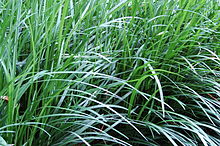Ophiopogon
| Ophiopogon | |
|---|---|

| |

| |
| Ophiopogon japonicus | |
| Scientific classification | |
| Kingdom: | Plantae |
| Clade: | Tracheophytes |
| Clade: | Angiosperms |
| Clade: | Monocots |
| Order: | Asparagales |
| Family: | Asparagaceae |
| Subfamily: | Nolinoideae |
| Genus: | Ophiopogon Ker Gawl. |
| Synonyms[1] | |
| |
Ophiopogon (lilyturf)[2] is a genus of evergreen perennial plants native to warm temperate to tropical East, Southeast, and South Asia.[1][3] Despite their grasslike appearance, they are not closely related to the true grasses, the Poaceae. The name of the genus is derived from Greek Όφις ophis, "snake", and πόγὦν pogon, "beard", most probably referring to its leaves and tufted growth.[4][5][6][7] In the APG III classification system, it is placed in the family Asparagaceae, subfamily Nolinoideae (formerly the family Ruscaceae).[8] Like many lilioid monocots, it was formerly classified in the Liliaceae.
They grow from short rhizomes, and bear tufts of leaves, from which flowers emerge in racemes held on short stems above the leaves.
- Species[1]
- - Guangdong
- - Guangxi
- - Sichuan, Yunnan
- - S China
- - S China, Vietnam
- - China, Bhutan
- - Thailand
- - SE Asia
- Ophiopogon chingii - S China
- - C + E Himalayas
- - S China
- - Thailand
- - N Myanmar
- - Guangxi, Guizhou
- - S China, N Indochina, E Himalayas
- - Guangxi
- - Yunnan
- - Yunnan, Guizhou, Myanmar
- - S China
- - Yunnan
- - Cambodia, Vietnam
- - S China, S + SE Asia
- - Korea, Jeju-do, Japan, Nansei-shoto
- Ophiopogon japonicus - E Asia, Philippines
- - Yunnan
- - Thailand
- - Yunnan, Guangxi, Vietnam
- - Assam
- - Vietnam
- - Yunnan
- - S China
- - Myanmar
- - S China, N Indochina
- - Yunnan
- - Yunnan
- - Assam
- - Tibet
- - Guangxi
- - Guangxi
- - Sichuan
- - S China, Vietnam
- - Cambodia
- - Yunnan
- Ophiopogon planiscapus - Japan
- - S China, Vietnam
- - Guangxi
- - Vietnam
- - S China, N Indochina, Assam
- - Guangxi, Hainan
- - Yunnan, Thailand
- - Uttarakhand
- - Yunnan, Guangxi
- - N Thailand
- - Yunnan, Guangxi
- - Guangxi, Guangdong
- - S China
- - Vietnam
- - Sichuan, Guizhou
- - Sichuan, Yunnan
- - Yunnan, Guangxi
- - Yunnan, Guangxi, Vietnam
- - Yunnan
- - S China
- - Vietnam
- - Yunnan
- - Yunnan
- - Sichuan, Yunnan
Cultivation and uses[]
Some species, such as O. japonicus and O. planiscapus, are used as ground-cover plants.
In Chinese medicine, the tuber of O. japonicus, known as mai men dong, is the cardinal herb for yin deficiency. According to the Chinese herbal medicine Materia Medica, the herb is sweet, slightly bitter, and slightly cold; it enters the heart, lung and stomach channels, thus nourishes the yin of the stomach, spleen, heart, and lungs, and clears heat and quiets irritability. It is used for hacking dry coughs, dry tongue and mouth, and constipation. Liriope is used as a substitute.[9]
References[]
- ^ a b c Kew World Checklist of Selected Plant Families
- ^ RHS A-Z encyclopedia of garden plants. United Kingdom: Dorling Kindersley. 2008. p. 1136. ISBN 978-1405332965.
- ^ Flora of China Vol. 24 Page 252 沿阶草属 yan jie cao shu Ophiopogon Ker Gawler, Bot. Mag. 27: t. 1063. 1807.
- ^ Germplasm Resources Information Network: Ophiopogon Archived 2009-01-15 at the Wayback Machine
- ^ Flora of China: Ophiopogon
- ^ Huxley, A., ed. (1992). New RHS Dictionary of Gardening. Macmillan ISBN 0-333-47494-5.
- ^ When Perennials Bloom: An Almanac for Planning and Planting By Tomasz Aniśko pg 342
- ^ Chase, M.W.; Reveal, J.L. & Fay, M.F. (2009), "A subfamilial classification for the expanded asparagalean families Amaryllidaceae, Asparagaceae and Xanthorrhoeaceae", Botanical Journal of the Linnean Society, 161 (2): 132–136, doi:10.1111/j.1095-8339.2009.00999.x
- ^ Bensky, D., Clavey, S., Stoger, E., & Gamble, A. (2004). Chinese Herbal Medicine Materia Medica, third edition. Eastland Press.
- Ophiopogon
- Asparagaceae genera
- Flora of Asia
- Garden plants of Asia
- Groundcovers